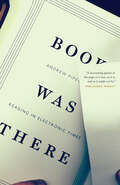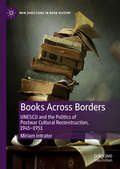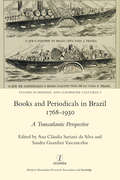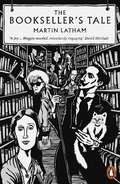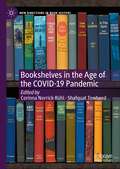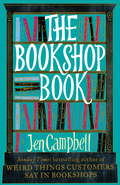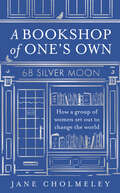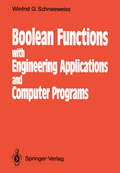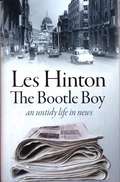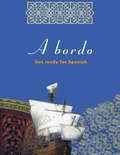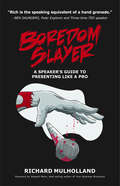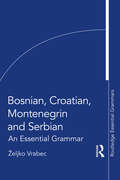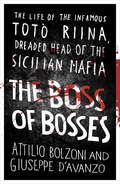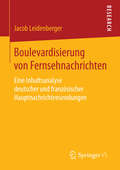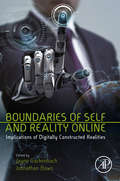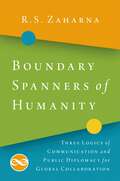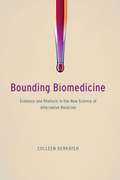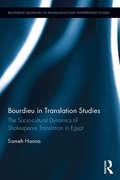- Table View
- List View
Book Was There: Reading in Electronic Times
by Andrew PiperAndrew Piper grew up liking books and loving computers. While occasionally burying his nose in books, he was going to computer camp, programming his Radio Shack TRS-80, and playing Pong. His eventual love of reading made him a historian of the book and a connoisseur of print, but as a card-carrying member of the first digital generation—and the father of two digital natives—he understands that we live in electronic times. Book Was There is Piper’s surprising and always entertaining essay on reading in an e-reader world. Much ink has been spilled lamenting or championing the decline of printed books, but Piper shows that the rich history of reading itself offers unexpected clues to what lies in store for books, print or digital. From medieval manuscript books to today’s playable media and interactive urban fictions, Piper explores the manifold ways that physical media have shaped how we read, while also observing his own children as they face the struggles and triumphs of learning to read. In doing so, he uncovers the intimate connections we develop with our reading materials—how we hold them, look at them, share them, play with them, and even where we read them—and shows how reading is interwoven with our experiences in life. Piper reveals that reading’s many identities, past and present, on page and on screen, are the key to helping us understand the kind of reading we care about and how new technologies will—and will not—change old habits. Contending that our experience of reading belies naive generalizations about the future of books, Book Was There is an elegantly argued and thoroughly up-to-date tribute to the endurance of books in our ever-evolving digital world.
Books Across Borders: UNESCO and the Politics of Postwar Cultural Reconstruction, 1945–1951 (New Directions in Book History)
by Miriam IntratorBooks Across Borders: UNESCO and the Politics of Postwar Cultural Reconstruction, 1945-1951 is a history of the emotional, ideological, informational, and technical power and meaning of books and libraries in the aftermath of World War II, examined through the cultural reconstruction activities undertaken by the Libraries Section of the United Nations Educational, Scientific and Cultural Organization (UNESCO). The book focuses on the key actors and on-the-ground work of the Libraries Section in four central areas: empowering libraries around the world to acquire the books they wanted and needed; facilitating expanded global production of quality translations and affordable books; participating in debates over the contested fate of confiscated books and displaced libraries; and formulating notions of cultural rights as human rights. Through examples from France, Poland, and surviving Jewish Europe, this book provides new insight into the complexities and specificities of UNESCO’s role in the realm of books, libraries, and networks of information exchange during the early postwar, post-Holocaust, Cold War years.
Books and Periodicals in Brazil 1768-1930
by AnaClaudiaSurianiDa SilvaBefore the Portuguese Royal Court moved to its South-American colony in 1808, books and periodicals had a very limited circulation there. It was only when Brazilian ports were opened to foreign trade that the book trade began to flourish, and printed matter became more easily available to readers, whether for pleasure, for instruction or for political reasons. This book brings together a collection of original articles on the transnational relations between Brazil and Europe, especially England and France, in the domain of literature and print culture from its early stages to the end of the 1920s. It covers the time when it was forbidden to print in Brazil, and Portugal strictly controlled which books were sent to the colony, through the quick flourishing of a transnational printing industry and book market after 1822, to the shift of hegemony in the printing business from foreign to Brazilian hands at the beginning of the twentieth century. Sandra Guardini Vasconcelos is Professor of English and Comparative Literature at the University of Sao Paulo.
Books and Periodicals in Brazil 1768-1930
by AnaClaudiaSurianiDa SilvaBefore the Portuguese Royal Court moved to its South-American colony in 1808, books and periodicals had a very limited circulation there. It was only when Brazilian ports were opened to foreign trade that the book trade began to flourish, and printed matter became more easily available to readers, whether for pleasure, for instruction or for political reasons. This book brings together a collection of original articles on the transnational relations between Brazil and Europe, especially England and France, in the domain of literature and print culture from its early stages to the end of the 1920s. It covers the time when it was forbidden to print in Brazil, and Portugal strictly controlled which books were sent to the colony, through the quick flourishing of a transnational printing industry and book market after 1822, to the shift of hegemony in the printing business from foreign to Brazilian hands at the beginning of the twentieth century. Sandra Guardini Vasconcelos is Professor of English and Comparative Literature at the University of Sao Paulo.
The Bookseller's Tale
by Martin Latham'The Bookseller's Tale is a joy. I read the first chapters in a single binge-read, and each chapter instantly became my favourite ... I loved this gnarly old bookshop in nifty book form' David Mitchell, author of Cloud Atlas'Entertaining, erudite, eccentric - a delight' Alison Light, author of Common People'The right book has a neverendingness, and so does the right bookshop.'This is the story of our love affair with books, whether we arrange them on our shelves, inhale their smell, scrawl in their margins or just curl up with them in bed. Taking us on a journey through comfort reads, street book stalls, mythical libraries, itinerant pedlars, radical pamphleteers, extraordinary bookshop customers and fanatical collectors, Canterbury bookseller Martin Latham uncovers the curious history of our book obsession - and his own. Part cultural history, part literary love letter and part reluctant memoir, this is the tale of one bookseller and many, many books.
Bookshelves in the Age of the COVID-19 Pandemic (New Directions in Book History)
by Corinna Norrick-Rühl Shafquat TowheedBookshelves in the Age of the COVID-19 Pandemic provides the first detailed scholarly investigation of the cultural phenomenon of bookshelves (and the social practices around them) since the start of the pandemic in March 2020. With a foreword by Lydia Pyne, author of Bookshelf (2016), the volume brings together 17 scholars from 6 countries (Australia, Canada, Germany, the Netherlands, the UK, and the USA) with expertise in literary studies, book history, publishing, visual arts, and pedagogy to critically examine the role of bookshelves during the current pandemic. This volume interrogates the complex relationship between the physical book and its digital manifestation via online platforms, a relationship brought to widespread public and scholarly attention by the global shift to working from home and the rise of online pedagogy. It also goes beyond the (digital) bookshelf to consider bookselling, book accessibility, and pandemic reading habits.
The Bookshop Book
by Jen CampbellWe're not talking about rooms that are just full of books. We're talking about bookshops in barns, disused factories, converted churches and underground car parks. Bookshops on boats, on buses, and in old run-down train stations. Fold-out bookshops, undercover bookshops, this-is-the-best-place-I've-ever-been-to-bookshops. Meet Sarah and her Book Barge sailing across the sea to France; meet Sebastien, in Mongolia, who sells books to herders of the Altai mountains; meet the bookshop in Canada that's invented the world's first antiquarian book vending machine. And that's just the beginning. From the oldest bookshop in the world, to the smallest you could imagine, The Bookshop Book examines the history of books, talks to authors about their favourite places, and looks at over three hundred weirdly wonderful bookshops across six continents (sadly, we've yet to build a bookshop down in the South Pole). The Bookshop Book is a love letter to bookshops all around the world. --"A good bookshop is not just about selling books from shelves, but reaching out into the world and making a difference." David Almond (The Bookshop Book includes interviews and quotes from David Almond, Ian Rankin, Tracy Chevalier, Audrey Niffenegger, Jacqueline Wilson, Jeanette Winterson and many, many others.)
A Bookshop of One’s Own: How A Group Of Women Set Out To Change The World
by Jane CholmeleyThe captivating true story of an underdog business – a feminist bookshop founded in Thatcher’s Britain – from a woman at the heart of the women’s liberation movement. An Independent and Stylist Best Non-Fiction Book for 2024
Boolean Functions: With Engineering Applications and Computer Programs
by Winfried G. SchneeweissModern systems engineering (e. g. switching circuits design) and operations research (e. g. reliability systems theory) use Boolean functions with increasing regularity. For practitioners and students in these fields books written for mathe maticians are in several respects not the best source of easy to use information, and standard books, such as, on switching circuits theory and reliability theory, are mostly somewhat narrow as far as Boolean analysis is concerned. Further more, in books on switching circuits theory the relevant stochastic theory is not covered. Aspects of the probabilistic theory of Boolean functions are treated in some works on reliability theory, but the results deserve a much broader interpre tation. Just as the applied theory (e. g. of the Laplace transform) is useful in control theory, renewal theory, queueing theory, etc. , the applied theory of Boolean functions (of indicator variables) can be useful in reliability theory, switching circuits theory, digital diagnostics and communications theory. This book is aimed at providing a sufficiently deep understanding of useful results both in practical work and in applied research. Boolean variables are restricted here to indicator or O/l variables, i. e. variables whose values, namely 0 and 1, are not free for a wide range of interpretations, e. g. in digital electronics 0 for L ==low voltage and 1 for H == high voltage.
The Bootle Boy: An Untidy Life In News
by Les HintonWhen Les Hinton first fulfils his schoolboy dream of working on Fleet Street, it is still a place awash in warm beer, black ink, fag ash, and hot metal. Fifty-two years after being sent out to buy a sandwich for his first boss, one Rupert Murdoch, when Les finally leaves Murdoch’s employment in 2011, the business of news has been turned upside down, in a tumble of social and technological change. Les Hinton has been present at and noiselessly directed several key scenes in that tale of revolutionary transformation, as employee and later head of Murdoch companies in newspapers, magazines, and television, on three continents over five decades, in Wapping and Wall Street, Australia and California. Born amid the rubble of the blitzed docklands of Bootle, and schooled by an itinerant Army childhood, he came to the centre from the periphery, just as Murdoch did. There, with a gang of like-minded outsiders, he set about redrawing the map of the media. Hinton depicts the upheavals that swept his trade with the same widescreen perspective and sharp colours he deploys to show us how politicians from Clinton to Blair, from Brown to Cameron, alternately canoodled and raged inside their arranged media marriages. We see the death of Diana, the IRA bombings, the charisma of Bill Clinton, and the phone-hacking scandal from a revelatory new angle. And we get the most undeluded and undiluted portrait yet of the man who is perhaps the last of the great press barons. Above all, emerging out of Hinton's scintillating stories of half a century of Murdoch and news revolutions, comes the voice of a wandering Liverpudlian who is still in love with the life of a newspaperman, and now the author of one of the defining media memoirs of our age.
A Bordo: Get Ready for Spanish
by Spanish Course TeamIdeal for near beginners, A bordo takes learners up to the equivalent of GCSE level Spanish. The course is accompanied by three audio-cassettes which include drama and dialogue. Features include:* focus on both Spanish and Latin-American culture* emphasis on communicating in everyday situations* varied exercises, with answer key and progress resumé at the end of each unit.A bordo is the preparatory course for En rumbo, also devised by the Open University Spanish team (see below).
A Bordo: Get Ready for Spanish
by Spanish Course TeamIdeal for near beginners, A bordo takes learners up to the equivalent of GCSE level Spanish. The course is accompanied by three audio-cassettes which include drama and dialogue. Features include:* focus on both Spanish and Latin-American culture* emphasis on communicating in everyday situations* varied exercises, with answer key and progress resumé at the end of each unit.A bordo is the preparatory course for En rumbo, also devised by the Open University Spanish team (see below).
Boredom Slayer: A speaker’s guide to presenting like a pro
by Richard MulhollandAny fool can put together a presentation; this book exists because so many do.There’s something sucking the life out of audiences everywhere, transforming them from the very people who can change your business into the disengaged masses. It’s called The Boredom … and your job is to slay it!It’s time to fight back.It’s time to save the world ...... one bored audience at a time.Whether you’re a seasoned public speaker, or getting ready for your first company presentation, this candid and practical guide by renowned global speaker and presentation coach Richard Mulholland will give you key insights.Grabbing and keeping an audience’s attention.Structuring talks that command fees and change companies.Dispelling the myths around public speaking that are getting in the way of that standing ovation.Speaking like a true leader.Richard Mulholland is the co-founder of global presentation powerhouses Missing Link and TalkDrawer. He is a renowned speaker and has presented his thinking in many countries including Canada, Puerto Rico, UK, USA, Germany, Kenya, and Pakistan. When not activating his audiences he can be found coaching many top CEOs and TED speakers to activate theirs.
Bosnian, Croatian, Montenegrin and Serbian: An Essential Grammar (Routledge Essential Grammars)
by Željko VrabecBosnian, Croatian, Montenegrin and Serbian: An Essential Grammar is intended for beginners and intermediate students who need a reference that explains grammar in straightforward terms. It covers all the main areas of the modern single BCMS grammatical system in an accessible way, and free from jargon. When linguistic terminology is used, it is explained in layman’s terms, the logic of a rule is presented simply and near parallels are drawn with English. This book covers all the grammar necessary for everyday communication (reaching B1 and B2 of the CEFR, ACTFL Intermediate-Intermediate- Mid). The book comprises of extensive chapters on all parts of speech, the creation of different word forms (endings for cases in nouns and adjectives, case forms for pronouns, tenses, verbal modes, verbal aspect etc.) and their uses in sentences. Each rule is illustrated with numerous examples from everyday living language used in Bosnia-Herzegovina, Croatia, Montenegro and Serbia. It is a unique reference book in English aimed at this level of language study that treats BCMS as a single grammar system, explaining and highlighting all the small differences between the four variants of this polycentric language.
Bosnian, Croatian, Montenegrin and Serbian: An Essential Grammar (Routledge Essential Grammars)
by Željko VrabecBosnian, Croatian, Montenegrin and Serbian: An Essential Grammar is intended for beginners and intermediate students who need a reference that explains grammar in straightforward terms. It covers all the main areas of the modern single BCMS grammatical system in an accessible way, and free from jargon. When linguistic terminology is used, it is explained in layman’s terms, the logic of a rule is presented simply and near parallels are drawn with English. This book covers all the grammar necessary for everyday communication (reaching B1 and B2 of the CEFR, ACTFL Intermediate-Intermediate- Mid). The book comprises of extensive chapters on all parts of speech, the creation of different word forms (endings for cases in nouns and adjectives, case forms for pronouns, tenses, verbal modes, verbal aspect etc.) and their uses in sentences. Each rule is illustrated with numerous examples from everyday living language used in Bosnia-Herzegovina, Croatia, Montenegro and Serbia. It is a unique reference book in English aimed at this level of language study that treats BCMS as a single grammar system, explaining and highlighting all the small differences between the four variants of this polycentric language.
The Boss of Bosses: The Life of the Infamous Toto Riina Dreaded Head of the Sicilian Mafia
by Giuseppe D'Avanzo Attilio BolzoniThis is the true story of Totò Riina, the Cosa Nostra boss who rose from nothing to become the most powerful man in Sicily. The picture emerges of a bloodthirsty, power-hungry monster who, despite his lowly beginnings, is able to outmanoeuvre the other Mafia chiefs and take control of the organisation. However, the story is not just that of Riina, but also of Sicily itself. D'Avanzo and Bolzoni have transformed a complex series of events spanning several decades into a gripping narrative.In prison for 18 years now, Totò Riina still remains the dictator of the Cosa Nostra. This book tells the haunting and disturbing tale, with thorough investigation and testimony of the Sicilian Corleone.
Boulevardisierung von Fernsehnachrichten: Eine Inhaltsanalyse deutscher und französischer Hauptnachrichtensendungen
by Jacob LeidenbergerJacob Leidenberger setzt sich mit dem Begriff der „Boulevardisierung“ auseinander und untersucht, ob sich deutsche und französische Fernsehnachrichten zwischen 1992 und 2010 hinsichtlich der behandelten Themen, des journalistischen Stils sowie im Hinblick auf die Präsentationsformen dem Boulevardformat angenähert haben. Mittels einer quantitativen Inhaltsanalyse von 125 Nachrichtensendungen und anhand mehrerer Experteninterviews mit Nachrichtenredakteuren prüft der Autor, ob in deutschen und französischen Abendnachrichten eine Boulevardisierung stattgefunden und diese im Lauf der Zeit an Bedeutung gewonnen hat. Gerade wegen der geringen Anzahl einschlägiger Studien in beiden Ländern trägt er dazu bei, ein wenig Licht ins „Boulevardisierungs-Dunkel“ zu bringen.
Boundaries of Self and Reality Online: Implications of Digitally Constructed Realities
by Jayne Gackenbach Johnathan BownAs technology continues to rapidly advance, individuals and society are profoundly changed. So too are the tools used to measure this universe and, therefore, our understanding of reality improves. Boundaries of Self and Reality Online examines the idea that technological advances associated with the Internet are moving us in multiple domains toward various "edges." These edges range from self, to society, to relationships, and even to the very nature of reality. Boundaries are dissolving and we are redefining the elements of identity. The book begins with explorations of the digitally constructed self and the relationship between the individual and technological reality. Then, the focus shifts to society at large and includes a contribution from Chinese researchers about the isolated Chinese Internet. The later chapters of the book explore digital reality at large, including discussions on virtual reality, Web consciousness, and digital physics.Cyberpsychology architectureVideo games as a tool for self-understandingAvatars and the meaning behind themGame transfer phenomenaA Jungian perspective on technologyPolitics of social mediaThe history and science of video game playTranscendent virtual reality experiencesThe theophoric quality of video games
Boundary Spanners of Humanity: Three Logics of Communications and Public Diplomacy for Global Collaboration
by R.S. ZaharnaWritten by a leading scholar of public diplomacy, Boundary Spanners of Humanity introduces a pan-human vision of communication that can revolutionize how we collaborate to solve global problems. Never before has humanity enjoyed better technological capabilities for interconnection than today. Ironically, rather than benefiting from the global pool of human resources and intellectual wealth to solve shared problems, nations are experiencing public discord and global divisions. Boundary Spanners of Humanity tackles the challenge of how to enhance global collaboration by introducing three pan-human logics of human communication and public diplomacy that can transform how we view diversity in an interconnected world. R.S. Zaharna begins by asking why the very tools needed for global collaboration-communication and public diplomacy-are undermining our efforts to work together. Her research reveals how contemporary communication is based on a nineteenth-century mindset of separateness that divided people into mutually exclusive cultural and national categories. That mindset reinforces human divisions and erodes global collaboration. In a radical break from conventional models, Zaharna introduces a vision of humanity-centered public diplomacy featuring three complementary logics of communication. Zaharna's innovative approach stems from decade-long, interdisciplinary research that spans from ancient cosmologies to emerging neurobiology. She draws on a rich array of global examples from ancient and indigenous precolonial diplomacies to spontaneous online communication during the Covid-19 pandemic to provide insights into overlooked aspects of emotion, empathy, spirituality, and synchrony in how nations and people communicate in the global arena. Ambitiously conceived, this book will bring a new, global understanding of how to conduct public diplomacy for the world's boundary spanners-those who would find commonality among our many divisions-and collaborate on humanity's shared global problems.
Boundary Spanners of Humanity: Three Logics of Communications and Public Diplomacy for Global Collaboration
by R.S. ZaharnaWritten by a leading scholar of public diplomacy, Boundary Spanners of Humanity introduces a pan-human vision of communication that can revolutionize how we collaborate to solve global problems. Never before has humanity enjoyed better technological capabilities for interconnection than today. Ironically, rather than benefiting from the global pool of human resources and intellectual wealth to solve shared problems, nations are experiencing public discord and global divisions. Boundary Spanners of Humanity tackles the challenge of how to enhance global collaboration by introducing three pan-human logics of human communication and public diplomacy that can transform how we view diversity in an interconnected world. R.S. Zaharna begins by asking why the very tools needed for global collaboration-communication and public diplomacy-are undermining our efforts to work together. Her research reveals how contemporary communication is based on a nineteenth-century mindset of separateness that divided people into mutually exclusive cultural and national categories. That mindset reinforces human divisions and erodes global collaboration. In a radical break from conventional models, Zaharna introduces a vision of humanity-centered public diplomacy featuring three complementary logics of communication. Zaharna's innovative approach stems from decade-long, interdisciplinary research that spans from ancient cosmologies to emerging neurobiology. She draws on a rich array of global examples from ancient and indigenous precolonial diplomacies to spontaneous online communication during the Covid-19 pandemic to provide insights into overlooked aspects of emotion, empathy, spirituality, and synchrony in how nations and people communicate in the global arena. Ambitiously conceived, this book will bring a new, global understanding of how to conduct public diplomacy for the world's boundary spanners-those who would find commonality among our many divisions-and collaborate on humanity's shared global problems.
Bounding Biomedicine: Evidence and Rhetoric in the New Science of Alternative Medicine
by Colleen DerkatchDuring the 1990s, an unprecedented number of Americans turned to complementary and alternative medicine (CAM), an umbrella term encompassing chiropractic, energy healing, herbal medicine, homeopathy, meditation, naturopathy, and traditional Chinese medicine. By 1997, nearly half the US population was seeking CAM, spending at least $27 billion out of pocket. Bounding Biomedicine centers on this boundary-changing era, looking at how consumer demand shook the health care hierarchy. Drawing on scholarship in rhetoric and science and technology studies, the book examines how the medical profession scrambled to maintain its position of privilege and prestige, even as its foothold appeared to be crumbling. Colleen Derkatch analyzes CAM-themed medical journals and related discourse to illustrate how members of the medical establishment applied Western standards of evaluation and peer review to test health practices that did not fit easily (or at all) within standard frameworks of medical research. And she shows that, despite many practitioners’ efforts to eliminate the boundaries between “regular” and “alternative,” this research on CAM and the forms of communication that surrounded it ultimately ended up creating an even greater division between what counts as safe, effective health care and what does not. At a time when debates over treatment choices have flared up again, Bounding Biomedicine gives us a possible blueprint for understanding how the medical establishment will react to this new era of therapeutic change.
Bounding Biomedicine: Evidence and Rhetoric in the New Science of Alternative Medicine
by Colleen DerkatchDuring the 1990s, an unprecedented number of Americans turned to complementary and alternative medicine (CAM), an umbrella term encompassing chiropractic, energy healing, herbal medicine, homeopathy, meditation, naturopathy, and traditional Chinese medicine. By 1997, nearly half the US population was seeking CAM, spending at least $27 billion out of pocket. Bounding Biomedicine centers on this boundary-changing era, looking at how consumer demand shook the health care hierarchy. Drawing on scholarship in rhetoric and science and technology studies, the book examines how the medical profession scrambled to maintain its position of privilege and prestige, even as its foothold appeared to be crumbling. Colleen Derkatch analyzes CAM-themed medical journals and related discourse to illustrate how members of the medical establishment applied Western standards of evaluation and peer review to test health practices that did not fit easily (or at all) within standard frameworks of medical research. And she shows that, despite many practitioners’ efforts to eliminate the boundaries between “regular” and “alternative,” this research on CAM and the forms of communication that surrounded it ultimately ended up creating an even greater division between what counts as safe, effective health care and what does not. At a time when debates over treatment choices have flared up again, Bounding Biomedicine gives us a possible blueprint for understanding how the medical establishment will react to this new era of therapeutic change.
Bounding Biomedicine: Evidence and Rhetoric in the New Science of Alternative Medicine
by Colleen DerkatchDuring the 1990s, an unprecedented number of Americans turned to complementary and alternative medicine (CAM), an umbrella term encompassing chiropractic, energy healing, herbal medicine, homeopathy, meditation, naturopathy, and traditional Chinese medicine. By 1997, nearly half the US population was seeking CAM, spending at least $27 billion out of pocket. Bounding Biomedicine centers on this boundary-changing era, looking at how consumer demand shook the health care hierarchy. Drawing on scholarship in rhetoric and science and technology studies, the book examines how the medical profession scrambled to maintain its position of privilege and prestige, even as its foothold appeared to be crumbling. Colleen Derkatch analyzes CAM-themed medical journals and related discourse to illustrate how members of the medical establishment applied Western standards of evaluation and peer review to test health practices that did not fit easily (or at all) within standard frameworks of medical research. And she shows that, despite many practitioners’ efforts to eliminate the boundaries between “regular” and “alternative,” this research on CAM and the forms of communication that surrounded it ultimately ended up creating an even greater division between what counts as safe, effective health care and what does not. At a time when debates over treatment choices have flared up again, Bounding Biomedicine gives us a possible blueprint for understanding how the medical establishment will react to this new era of therapeutic change.
Bounding Biomedicine: Evidence and Rhetoric in the New Science of Alternative Medicine
by Colleen DerkatchDuring the 1990s, an unprecedented number of Americans turned to complementary and alternative medicine (CAM), an umbrella term encompassing chiropractic, energy healing, herbal medicine, homeopathy, meditation, naturopathy, and traditional Chinese medicine. By 1997, nearly half the US population was seeking CAM, spending at least $27 billion out of pocket. Bounding Biomedicine centers on this boundary-changing era, looking at how consumer demand shook the health care hierarchy. Drawing on scholarship in rhetoric and science and technology studies, the book examines how the medical profession scrambled to maintain its position of privilege and prestige, even as its foothold appeared to be crumbling. Colleen Derkatch analyzes CAM-themed medical journals and related discourse to illustrate how members of the medical establishment applied Western standards of evaluation and peer review to test health practices that did not fit easily (or at all) within standard frameworks of medical research. And she shows that, despite many practitioners’ efforts to eliminate the boundaries between “regular” and “alternative,” this research on CAM and the forms of communication that surrounded it ultimately ended up creating an even greater division between what counts as safe, effective health care and what does not. At a time when debates over treatment choices have flared up again, Bounding Biomedicine gives us a possible blueprint for understanding how the medical establishment will react to this new era of therapeutic change.
Bourdieu in Translation Studies: The Socio-cultural Dynamics of Shakespeare Translation in Egypt (Routledge Advances in Translation and Interpreting Studies)
by Sameh HannaThis book explores the implications of Pierre Bourdieu’s sociology of cultural production for the study of translation as a socio-cultural activity. Bourdieu’s work has continued to inspire research on translation in the last few years, though without a detailed, large-scale investigation that tests the viability of his conceptual tools and methodological assumptions. With focus on the Arabic translations of Shakespeare’s tragedies in Egypt, this book offers a detailed analysis of the theory of ‘fields of cultural production’ with the purpose of providing a fresh perspective on the genesis and development of drama translation in Arabic. The different cases of the Arabic translations of Hamlet, Macbeth, King Lear and Othello lend themselves to sociological analysis, due to the complex socio-cultural dynamics that conditioned the translation decisions made by translators, theatre directors, actors/actresses and publishers. In challenging the mainstream history of Shakespeare translation into Arabic, which is mainly premised on the linguistic proximity between source and target texts, this book attempts a ‘social history’ of the ‘Arabic Shakespeare’ which takes as its foundational assumption the fact that translation is a socially-situated phenomenon that is only fully appreciated in its socio-cultural milieu. Through a detailed discussion of the production, dissemination and consumption of the Arabic translations of Shakespeare’s tragedies, Bourdieu in Translation Studies marks a significant contribution to both sociology of translation and the cultural history of modern Egypt.
